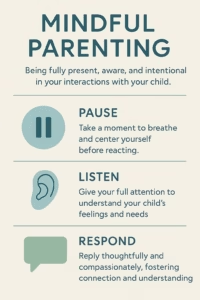Definition of Mindful Parenting
Mindful parenting means bringing intentional, nonjudgmental awareness to your interactions with your child. It involves:
-
Pausing before reacting
-
Listening fully to your child’s words and feelings
-
Responding with curiosity and compassion
This approach helps you stay present, rather than drifting into autopilot or reacting out of stress.
Benefits of Mindful Parenting
Mindful parenting practices offer lasting benefits:
-
Enhanced parent–child connection as you truly listen and engage
-
Reduced parental stress by noticing emotions before they escalate
-
Improved emotional regulation in children through your calm modeling
-
Greater family harmony as everyone learns to communicate mindfully
How-To Steps
1. Pause and Breathe

When you notice tension bubbling—tightly clenched jaw, racing thoughts, or a sudden urge to raise your voice—stop what you’re doing and close your eyes for a moment. Take three slow, deliberate breaths:
-
Inhale deeply through your nose, counting to four.
-
Hold the breath for a gentle two-count.
-
Exhale fully through your mouth for a count of six.
As you breathe, scan your body: feel your shoulders drop, notice your chest rising and falling, and sense your heartbeat settling into a calmer rhythm. This brief interlude creates a mental gap between feeling and reaction, giving you space to choose kindness over impatience.
Try placing a small sticky note or setting a gentle chime on your phone as a reminder to pause during hectic moments. Over time, this practice becomes an automatic reset—helping you pick your battles wisely rather than reacting in the heat of the moment. For more on choosing your responses, read The Importance of Picking Your Battles.
2. Practice Active Listening
When your child speaks, drop what you’re doing and kneel or sit so your eyes meet theirs. Keep your posture open—uncrossed arms, gentle nods—and focus fully on their words and emotions. After they pause, reflect back what you heard by saying something like, “You feel worried about school tomorrow. Tell me more about what’s on your mind.” This simple echo shows you’re truly present and helps your child feel seen, heard, and understood.
3. Engage in Mindful Play

Choose a short, consistent time each day—perhaps after dinner or before bath—and turn off phones, TVs, and other distractions. Let your child decide the activity, whether it’s building with blocks, drawing, or pretending to be astronauts. As you play, silently note moments that make your child laugh or concentrate deeply, then share your observations: “I love how focused you are stacking those blocks!” This attentive play not only deepens your bond but also teaches your child that their interests deserve your full attention.
4. Use Gentle Reminders
Throughout the day, prompt mindfulness with simple cues:
-
“Let’s take a calm moment.”
-
“Feel your feet on the ground.”
-
“Notice your breathing for just five seconds.”
-
“Let’s check in with how our body feels right now.”
-
“Pause and see what you can hear in this moment.”
5. Reflect Together
Set aside a cozy bedtime ritual—dim the lights, snuggle under a soft blanket, and create a safe space for sharing. Then:
-
“Rose and Thorn” Sharing: Each person names one “rose” (a highlight) and one “thorn” (a challenge) from the day.
– Rose example: “I loved building that tower with you.”
– Thorn example: “I felt frustrated when homework took so long.” -
Gratitude Jar: Keep a small jar and slips of paper by the bedside. Take turns writing or drawing something you’re thankful for, fold it, and drop it in the jar. Over time, the jar becomes a visual reminder of daily blessings.
-
Compliment Circle: Each of you gives the other a heartfelt compliment. This practice boosts self-esteem and ends the day on a positive note.
By turning reflection into a playful, loving ritual, you nurture emotional awareness, strengthen your bond, and help your child—and yourself—fall asleep with a grateful heart.
Mindful Parenting Journal
I wholeheartedly recommend the Mindful Parenting Journal by Patricia C. Broderick as your next step toward deeper connection and calm at home. Priced at $24.99 with a stellar 4.6-star rating from over 1,200 reviews, this journal stands out for its blend of research-backed exercises and warm, conversational prompts.
Each page invites you to pause and reflect through activities like guided breathing checks, gratitude lists, and “moment-capture” sketches—all designed to be completed in just five minutes a day. Patricia’s approachable voice and clear instructions make it easy to weave mindful parenting practices into even the busiest schedules. Whether you’re new to mindfulness or looking to deepen your existing habits, this journal offers practical, bite-sized guidance that transforms routine moments into mindful connections.
Conclusion
Try weaving these mindful parenting practices into one simple routine at a time. Notice how pausing, listening, and playing with full attention can transform family life. Celebrate each small shift toward presence—you’re building a calmer, more connected household.

